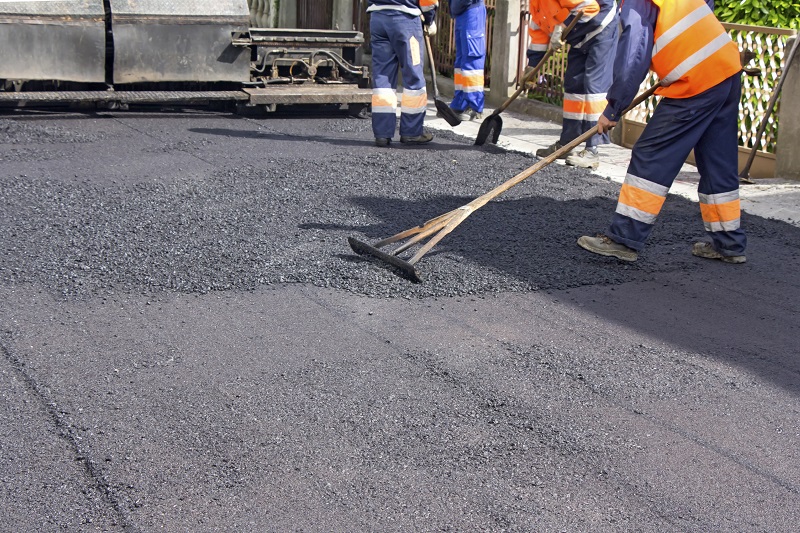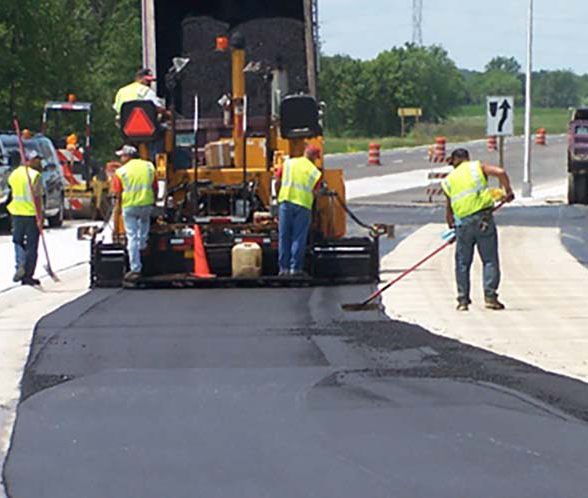Maximize Area Effectiveness with Hot Mix Asphalt Angled Parking Lot Solutions
Opening the Tricks of Warm Mix Asphalt Modern Technology
Checking out the depths of warm mix asphalt modern technology uncovers a world where specific formulas and precise procedures converge to form our roads and framework. The combination of binders, fillers, and accumulations isn't simply a building job however a strategic orchestration of durability and effectiveness.
Importance of Warm Mix Asphalt
Hot Mix Asphalt plays a critical duty in contemporary infrastructure advancement due to its toughness and cost-effectiveness. As the most frequently made use of paving product for roadways, highways, and car park, Warm Mix Asphalt provides a series of benefits that contribute to its value in construction projects. One key advantage is its capacity to stand up to hefty web traffic lots and harsh climate condition, supplying a trustworthy and long-lasting surface for transport networks. Furthermore, Hot Mix Asphalt is affordable in both first construction and long-term maintenance, making it a favored selection for several infrastructure jobs.
The durability of Warm Mix Asphalt stems from its composition, which consists of accumulations, binder, and filler materials that are carefully picked and blended to meet details performance requirements. Generally, the significance of Warm Mix Asphalt in facilities development can not be underrated, as it proceeds to be a cornerstone of modern-day construction techniques.
Parts of Asphalt Mixes
The make-up of asphalt mixes contains thoroughly chosen accumulations, binder, and filler materials that are critical for accomplishing details performance needs. Aggregates are the main component of asphalt mixes, supplying stamina and security. These aggregates can be natural, such as crushed rock or crushed stone, or artificial, like recycled products from old pavements. The binder, normally asphalt or asphalt concrete, holds the aggregates with each other and provides versatility and durability to the mix. The choice of the binder is critical as it directly influences the mix's performance in various weather. Fillers, such as moisturized lime or Rose city cement, are used to enhance the mix's workability and aging resistance. Angled Parking.
The combination and proportion of these elements play a considerable function in identifying the high quality and performance of the asphalt mix. Engineers thoroughly create the mix to fulfill details needs, taking into consideration variables like website traffic quantity, environment conditions, and pavement lifespan. Correct selection and harmonizing of accumulations, binder, and fillers are crucial for developing sturdy, durable asphalt sidewalks.
Mixing and Production Strategies

When the accumulations are chosen, the binder, usually asphalt concrete, is included to bind the products straight from the source with each other. The binder's top quality and amount substantially influence the mix's versatility, stamina, and resistance to ecological aspects. Furthermore, fillers like hydrated lime or Portland concrete might be integrated to enhance specific characteristics of the asphalt mix, such as its workability or dampness resistance.
Throughout production, the aggregates and binder are warmed, commonly in between 250-325 ° F(121-163 ° C ), to assist in mixing and ensure correct finish of the aggregates. The blending process should be comprehensive to achieve an uniform blend that promotes the wanted performance characteristics of the asphalt. Numerous methods, such as batch blending or drum blending, are employed to attain constant and top quality asphalt mixes for building and construction jobs.
Factors Affecting Asphalt Performance
Variables influencing asphalt efficiency incorporate a range of variables that affect the longevity, longevity, and general top quality of asphalt sidewalks. One key aspect is the top quality of materials made use of in the asphalt mix.

Ecological conditions also influence asphalt performance. Temperature variations, dampness infiltration, and website traffic loads can all affect the architectural honesty of the sidewalk. Style factors to consider, such as sidewalk density and water drainage, are crucial in making sure the long-lasting performance of the asphalt pavement. By carefully taking into consideration these aspects, specialists and designers can maximize asphalt efficiency and improve the life span of sidewalks.
Sustainable Practices in Asphalt Modern Technology

WMA allows for the manufacturing and positioning of asphalt mixes at reduced temperatures compared to standard hot-mix asphalt, resulting in reduced power intake and greenhouse gas exhausts. The usage of porous asphalt blends can aid reduce stormwater drainage concerns by allowing water to penetrate with the pavement and right into the ground, promoting natural water filtration and reenergize processes.
Verdict
In conclusion, hot mix asphalt innovation plays an essential function in modern-day infrastructure advancement due to its longevity and cost-effectiveness. By very carefully stabilizing elements, using appropriate blending methods, and thinking about numerous factors, engineers can produce high-quality asphalt blends that withstand find here rush hour lots and rough climate condition. Embracing sustainable practices, such as making use of recycled materials and warm-mix modern technologies, additionally enhances the ecological kindness of asphalt innovation.
Mixing and manufacturing strategies in hot mix asphalt modern technology include the specific mix and handling of accumulations, binder, and fillers to produce a resilient and high-performance asphalt mix.Factors affecting asphalt performance incorporate a variety of variables that influence the sturdiness, durability, and general quality of asphalt sidewalks. Lasting practices in asphalt innovation encompass numerous initiatives aimed at lowering the ecological impact of asphalt manufacturing and paving processes. By integrating redeemed asphalt sidewalk (RAP) and recycled asphalt tiles (RAS) into brand-new asphalt blends, the industry can considerably minimize the intake of raw products and energy, while likewise reducing garbage dump waste.
WMA permits for the manufacturing and positioning of asphalt mixes at reduced temperature levels compared to conventional hot-mix asphalt, resulting in lowered energy usage and greenhouse gas exhausts.